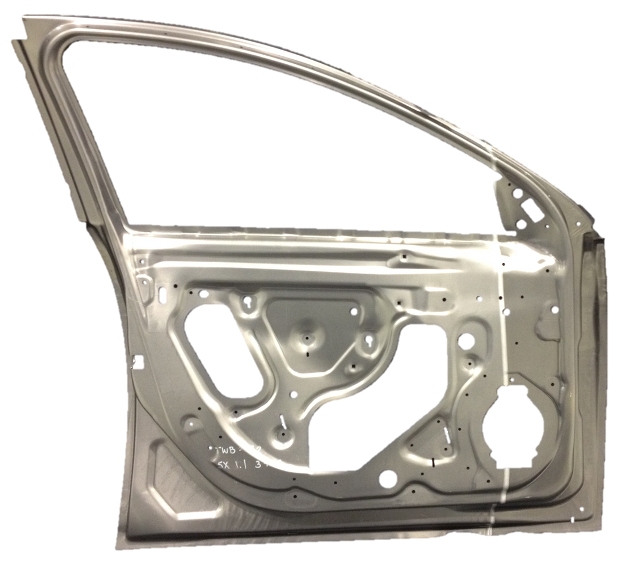A joining method known as friction stir welding or FSW has been transformed by researchers at the Pacific Northwest National Laboratory of the Department of Energy to manufacture lightweight and strong components at reduced production time and cost.
 PNNL's process joins (white line) a thicker gauge of aluminum near the door hinge, where additional strength is needed, to a thinner gauge used throughout the rest of the door panel, resulting in a 62 percent reduction in weight. Image courtesy of TWB Company LLC
PNNL's process joins (white line) a thicker gauge of aluminum near the door hinge, where additional strength is needed, to a thinner gauge used throughout the rest of the door panel, resulting in a 62 percent reduction in weight. Image courtesy of TWB Company LLC
For instance, a car door produced by this novel technique is 62% lighter and 25% less costly than that produced with existing manufacturing techniques. The researchers collaborated with Alcoa, General Motors and TWB company.
Aluminum sheets of varying thicknesses can be effectively joined using this high-volume joining process. This is a key for manufacturing auto components that are both light and strong. The speed attained by the process developed by PNNL is ten times faster than that of existing FSW methods.
This research is published in the May issue of JOM, the member journal of The Minerals, Metals & Materials Society.
We looked at the barriers preventing the use of more lightweight alloys in cars, picked what we felt was a top challenge, and then formulated a team that represented the entire supply chain to tackle it. The result is a proven process that overcomes the speed, scale and quality limitations of FSW that previously were showstoppers for the auto industry.
Yuri Hovanski, the program manager at PNNL and lead author
The funding of this six-year, two-phase project is from the Department of Energy's Office of Energy Efficiency and Renewable Energy with in-kind partner contributions from all the participating companies.
The fabrication of hoods, door frames and other auto components requires welding of metal sheets end-to-end to create a "tailor-welded blank", which is afterward cut into adequate sizes before stamping into the final shape. This process enables a considerable degree of customization. For instance, a thicker gauge of metal is joined to the side of the car component requiring additional strength, and a thinner gauge is used on the side that does not require additional strength.
For joining varying thicknesses of steel, conventional laser welding is ideal. However, it is not suitable to join aluminum because of the reactivity of molten aluminum to air. Hence, manufacturers have to fabricate components from individual sheets, followed by stamping and riveting them together. This leads to a number of production steps and more components, thus eventually increasing weight and cost.
Reducing the weight of a vehicle by 10% can decrease fuel consumption by 6%-8%, so the auto industry is very interested in a welding technique such as FSW that is aluminum friendly.
Hovanski
The appearance and functioning of a friction-stir welding machine is similar to a cross between a sewing machine and a drill press. The drill bit or the pin tool is lowered onto two adjacent metal sheets and spins against either edge. As the drill bit or pin moves along, friction is created, which heats, blends and joins the alloys without melting them. This process, however, is very slow in terms of production standards wherein just one-half-meter is welded each minute. Hence, this technique is adopted only for very specific applications.
The new aluminum joining process described by PNNL researcher Yuri Hovanski and the industry collaboration will help it to be used in mass auto production. Before choosing FSW, Howanski and PNNL colleagues compared a number of joining techniques and concluded that only FSW passed all GM’s rigorous weld quality specifications. After that the researchers did a detailed series of lab-scale welding tests on Alcoa’s aluminum sheets.
A large number of innovative tool designs with differing lengths, shapes and diameters of the pin were created. These were examined against a range of weld parameters such as the rotation speed, depth and tool angle. The team then determined the right combination of weld parameters and tool specifications that are capable of reliably withstanding high-speed production demands, using statistical analysis techniques.
"What we discovered was a win-win," Hovanski said. "The faster the weld, the better the quality and strength of the join, thus the significant increase in speed."
The tool and weld specifications were given by PNNL to GM and TWB company. TWB then welded, formed and studied over 100 aluminum banks in close cooperation with GM, making it the first qualified aluminum tailor-welded blank supplier. After that, GM stamped its first defect-free, full-sized inner door panel supplied by TWB, using aluminum sheets of different thicknesses.
Now, TWB has a FSW machine based on PNNL’s process at its Monroe, Michigan manufacturing facility, which is capable of manufacturing up to 250,000 components annually. A GM group manager, who conceptualized the project, Blair Carlson stated that "TWB can now provide aluminum tailor welds not only to GM, but the entire automotive industry,"
The team has two more years of funding and is focusing on higher weld speeds and the ability to move around the corners and contours of complicated aluminum components for which laser welding is not possible. The team is also working on customizing FSW to weld different alloys such as automotive-grade aluminum alloys and light, ultra-high strength alloys engineered for aerospace applications.
"Going forward, we see this process, and future versions of it, enabling completely novel combinations of materials that will revolutionize material use in the auto industry," Hovanski said.
References